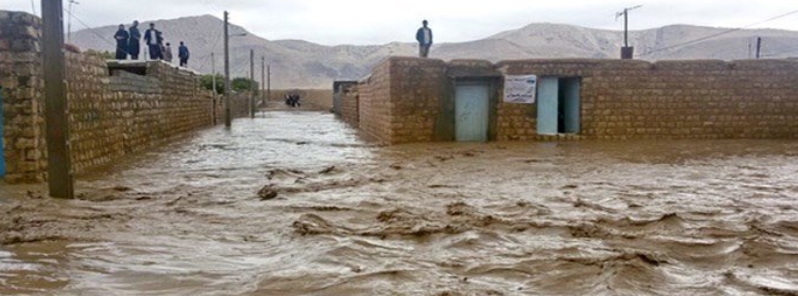Heavy rains trigger destructive flash floods and landslides in southern Iran

Heavy rainfall affecting southern Iraq since March 21, 2020, resulted in destructive flash floods and landslides responsible for at least 12 fatalities and 17 injuries across several provinces. Extensive damage was reported, as well as power outages in several villages.
According to Tasnim News Agency, intense downpours over the past days caused flash floods and swollen rivers, affecting the provinces of Farsh, Bushehr, Hormozgan, Kerman, and Sistan and Baluchestan.
Other provinces also hit by inundations are the northern province of Gilan, Golestan, Kohgiluyeh, Boyer-Ahmad in the west, and the central province of Qom.
In the province of Bushehr, several villages suffered power outages while mudslides occurred between Rahak and Dir cities.
On Monday, March 23, the spokesperson for Iran's Emergency Medical Service confirmed that the severe weather claimed 12 lives and injured 17 across the affected provinces. Two others remain unaccounted for.
Five of the fatalities were in Fars, while two were in Kangan in Bushehr.
Heavy flood in Bandar-e Kangan, Iran
It literally shovels everything! pic.twitter.com/g91gwe2Y2X
— Farhang F. Namdar (@FarhangNamdar) March 23, 2020
Rudbar-e Jonubi County, Kermam, SE #Iran
Seasonal rains have led to severe flooding due to a lack of infrastructure and years of environmental damage in the country.According to Iranian officials, 11 people have died in the past 24 hrs in the floods in 4 cities. pic.twitter.com/vE2hEotBrK
— Iran News Wire (@IranNW) March 23, 2020
Heavy flood in Bandar-e Deyr in Iran pic.twitter.com/QkEnT2akAZ
— Farhang F. Namdar (@FarhangNamdar) March 22, 2020
If the #coronavirus wasn’t enough – #Iran is afflicted with heavy #floods at the #Bushehr region. pic.twitter.com/6lBRtMWvHF
— Amir Tsarfati (@BeholdIsrael) March 22, 2020
Our fellow citizens across 7 provinces in south-southeast & East of #Iran are struggling with flash #floods. At least 7 have died, roads washed out, power cut in dozens of villages and airlifting underway in remote areas. Half a town in south of #Kerman inundated. pic.twitter.com/YMk825AFb2
— Fereshteh Sadeghi فرشته صادقی (@fresh_sadegh) March 23, 2020
Torrential rainfall has prompted authorities in some cities to declare a state of emergency and order evacuations.
According to the governor of Chabahar in Sistan and Baluchestan, rains over a 24-hour period into Monday, March 23 have resulted in extensive damage to infrastructure in the city, as well as in the other urban and rural parts of the region.
The Iranian Red Crescent Society (IRCS) said rescue and relief operations are underway in the impacted areas. In addition, IRCS officials in Sistan and Baluchestan have mobilized rescue efforts using helicopters.
On March 15, the Iranian Minister of Energy Reza Ardakanian announced that after considering weather forecasts indicating that some parts of the country will be hit by heavy rains, preparations have been made to deal with the situation.
Noting the flash floods in 2019, the Iranian Minister of Energy, Reza Ardakanian, said his ministry has done efforts to better handle the conditions of the dams.
"At present, 40 percent of the 50 billion cubic m (1.7 billion cubic feet) capacity of the country's dams is empty, which means [there are] enough capacity to receive spring floods."
بی کفایتی مدیران فاسد نظام، بلای جان مردم است!
عبور خودورها از روی پلی در میناب که هر آن ممکن است سیل خرابش کند!#HumanRights #Iran pic.twitter.com/tKt7OZwPWU— مانيتورينگ حقوق بشر ایران (@Iran_HRM) March 23, 2020
سیل در #بوشهر دارد مردم را با خودش میبرد. این یک فاجعه انسانی است.کاش مردم از تمام مسیلها و مسیرها ی رودها دوری کنند. سیل ممکن است ناگهان به یک جاده یا روستا برسد. pic.twitter.com/qKPCkX6PHB
— Azam Bahrami (@AzamBahrami) March 23, 2020
خامنه ای مشغول مبارزه جن و اجنه هست بخشی ازهموطنان ما برای بار چندم قربانی سیل هستند که ساده ترین کارها برای پیشگیری از خرابی هایش سیل بند و…. انجام نشده و حکومت هم در فکر کمک به سیلزدگان نیست.
مرگ بر خامنه ای و طرفدانان مزدورش#KhameneiVirus pic.twitter.com/wox7ZgpyS9— M:S (@Ms79744326) March 23, 2020
ماشاء الله سيل نوخان مديرية عتق pic.twitter.com/KZSA4hWo7B
— طقس شبوة (@shabwahweather) March 22, 2020
مردم به حال خود رها شده اند یعنی ھمین: جنوب کرمان سیل به تعداد زیادی از مردم زیان رسانده و اثری از دولت و امدادهای فوری نیست#KhameneiVirus pic.twitter.com/IG9gJjO11l
— خواجه تاج دار (@piman212121) March 23, 2020
Featured image credit: @fresh_sadegh/Twitter

Commenting rules and guidelines
We value the thoughts and opinions of our readers and welcome healthy discussions on our website. In order to maintain a respectful and positive community, we ask that all commenters follow these rules.